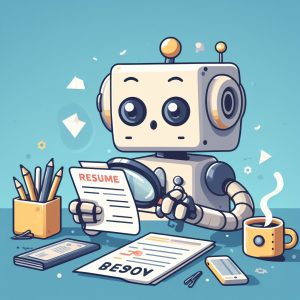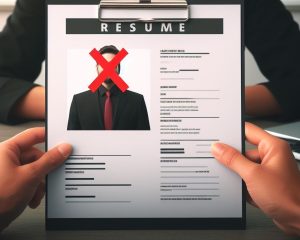9 Crafting Your Professional Story: The Art of Resume Building
Lynn Meade

What is a Resume?
A resume is a short document that highlights your skills, accomplishments, and experiences in a concise and organized format.
Why Create a Resume for a Portfolio?
There are several reasons why adding your resume to your portfolio can be beneficial:
- Meeting expectations: Resumes are an expected part of the career development process.
- Professional presentation: Including a resume in your portfolio adds a level of professionalism and structure to your online presence.
- Comprehensive overview: By including a resume in your portfolio, you can offer visitors a quick snapshot of your qualifications making it easier for them to assess your suitability for various opportunities.
- Ease of sharing and accessibility: With an online portfolio, you can easily share your resume with others by providing them with a link to your portfolio website. This makes it convenient for potential employers to access your resume.
- Ease of forwarding: There are times when your mentor might want to forward your credentials and having your resume online makes it easier and more efficient. in addition, employers report that they often forward candidates’ information to friends they know who are looking to hire.
Getting Started
Collecting your materials and brainstorming is the first step in building a resume.
- Make a list of all your jobs, and volunteer experiences complete with dates and key duties.
- Do an occupation keyword search on O*NET OnLine and see ways to describe positions you have held.
- Look at the verb list and then write down all of them that apply to your experiences.
- Do an internet search for your career field and look at resumes to see the language used and formatting.
Taking the time to brainstorm and to get a feel for resume types in your field before you begin writing will help the process go smoother and with stronger results.
Sample Resumes
As you build your resume, it can be helpful to look at the resumes of others. When possible, look at the resumes of those from similar fields.
University of Arkansas, Career Connections: Sample resumes based on major.
Resume Samples from Harvard University

Know Your Audience
Generic resumes are seldom effective. Research the audience and the industry that will be viewing your portfolio and resume and pick headings and buzzwords that will appeal to that audience. Many career specialists use applicant tracking systems, a tool that searches for keywords in your resume and matches them to the positions available. Knowing and using industry keywords and using the proper headings will help you get your resume noticed.

Beat the Bot: What You Need to Know About Applicant Tracking Systems
When writing your resume, you should consider bots–digital software as part of your audience. Many employers use applicant tracking systems to streamline their recruitment efforts. As a result, job seekers must be strategic when crafting their resumes to ensure their documents are optimized for Applicant Tracking System (ATS) compatibility. If an employer mentions specific skills in a job description, it’s safe to assume they want someone with those particular skills. Using “keywords” in your resume from the job posting will increase your resume’s chances of getting past the ATS, but it may also increase your chances of getting called in for an interview.
When building your resume, you should consider the following:
- Always include keywords. Use the same language on your resume that is used in the job description.
- Use plain fonts: Times New Roman, Arial, Helvetica
- Avoid tables and columns.
- Avoid headers and footers.
- Avoid textboxes.
- Use traditional headings like “Education” and “Work Experience.”
- Keep it plain. Avoid graphics and embellishments.
- Think about the essential skills for a job and make sure you include those.
Check Your Knowledge About Applicant Tracking Systems
Pick Your Resume Headings
Most employers either use applicant tracking systems or do a quick glance at resumes to look for crucial elements. If those elements are present, they may take a longer look. Your goal is to design your resume so that the important information is easily accessible. One way to do that is with headings. Your resume heading shines a spotlight on the main things that you want an employer to notice.
Here are some possible resume headings.
|
|
| Education Honors & Awards Internship Experience Study Abroad Experience Relevant Coursework Scholarships Campus Involvement Certifications AchievementsMilitary Service Special Recognition |
Community Involvement & Service Computer Languages & Skills Leadership Publications Professional Development & Training Professional Experience Skills Summary Volunteer Activities |
“The set-up of the resume is based on the job description.
I make sure students put their soft and hard skills on the resume.
Many students miss their transferable soft skills,”
Cara Martinez, career specialist at the career center for the University of Baltimore.

Write About Your Education
Tailor your education section to highlight the most relevant information for the specific job or industry you are applying to. Prioritize details that showcase your qualifications and align with the employer’s requirements. You will want to put your education on your resume in a way that is easy to read.
- List your education in chronological order (put your most recent education first).
- List the degree, the college, and the city and state where you earned your degree.
- In a 2019 study from NACE, only 37% of employers surveyed use GPAs to screen candidates. Because of this, there are different schools of thought about the need to include your GPA or not. If it is 3.0 or above, I would suggest you include it.
- You can put your grade point average in your major if it is higher than your overall grade point.
- If you are in your last two semesters of college, you can write “expected date of graduation.”
- If you are in your first few years of college, you can put “studying” or “majoring in.” (Never make it look like you have a degree if you haven’t earned one yet).
- You may list specific courses if they highlight skills you possess that relate to the job posting.
- Once you are in college, you no longer need to mention high school.
- If you have been out of school for a few years and have some relevant work experience, include your education section underneath your professional experience.
- If you graduated recently and your education is your most relevant experience, put your education section at the top of your resume.
- Most people include honors and study abroad in your education section.
- If you have many specialized training, certifications, or licenses list them in a separate section or include them with your education. Be sure to include the certifying or licensing organizations and the dates of validity for your credential.
Examples of Different Ways to Include Education on Your Resume
(click below to expand each item. This information is also included at the end of the chapter for those using the pdf version of the book)

Honors and Certifications
When it comes to honors and awards, you need to decide which to include and how to report them.
Example of How to Write About Honors and Awards on Your Resume
HONORS & AWARDS
Chancellor’s Scholarship ($7,000/yr for 4 years) August 2022 – Present
Awarded to the top 10% of University of Arkansas candidates from the general applicant pool
Walton College of Business Finance Department Scholarship ($2500) January – May 2022
Awarded to top 5 finance majors with strong academic records
Notice that in these examples, the award is mentioned as well as why the award is important. Saying you have the AARCLST award means nothing unless you write out what the letters represent and why the award is important.

Summary of Qualifications, Skills, or Professional Profile
A well-written summary of qualifications or professional profile section can be used to quickly showcase your relevant skills, strengths, or qualifications for a specific position in a short, clear section right at the beginning of your resume. It can also be a surefire way to capture the reader’s interest. Hiring managers save time and energy usually spent reading through the entire resume by reading the highlighted qualifications in the summary and can get a basic understanding of what a candidate can offer their company or organization. It is also a great place to include keywords from the job posting which will increase your resume’s chances of getting past the Applicant Tracking Systems (ATS).
The summary or profile section usually includes a bulleted list of three to five key strengths, skills, or experiences that make you qualified for a position or industry. It usually lists skills, strengths, or other qualifications that are based on “hard skills” not necessarily “soft skills”. Hard skills are specific teachable abilities based on facts. Either you’re fluent in another language or you aren’t. You either obtained a certificate or you didn’t. You either know a particular software program or you don’t. These are based on facts and are good for a summary or profile section. Soft skills on the other hand are subjective and based on opinion. They are often associated with personal attributes and character. Examples include motivated team player, strong communicator, hard worker, and detail-oriented. These are skills that anyone can list on a resume and are considered cliché. A recruiter or hiring manager wants to see proof of these skills as opposed to just lists of them. Employers see these phrases repeatedly, and they don’t bring as much impact as actual hard skills. Soft skills are best used within your work experience descriptions to describe the type of work you are doing or did. If you do decide to use soft skills in this section, remember to provide some evidence of the skills listed by using numbers and percentages to demonstrate accomplishments and impact.
Tips for Writing a Good Summary of Qualifications or Profile:
- Read the job posting thoroughly to understand the key requirements, skills, qualifications, and responsibilities of the position.
- Identify and highlight the specific keywords and phrases that are relevant to the job. These may include hard skills such as technical skills, certifications, languages in which you are fluent, job titles, industry-specific terms and soft skills.
- Next, identify the relevant qualifications and skills you possess or can demonstrate. If you have already done this for your experience section, you are ready to create a 3-6 summarized bulleted list of your hard skills or quantifiable soft skills that match those found in the job posting.
- Tailor the section for each position for which you are applying.
Example of Summary of Qualifications
Summary of Qualifications
Senior communication major at the University of Arkansas with a combined 4 years of customer service, sales, and leadership experience. Strengths include:
- Superior Customer Service – 99% positive feedback from customer satisfaction surveys
- Ability to Increase Profits – Learned tactics to improve sales for 50% of customer orders
- Global Experience – Fluent in Italian; strong interpersonal skills working in diverse teams
For more examples of profile or summary qualifications

Incorporating Keywords
Since an employer mentioned a skill in a job description, it’s safe to assume they want someone with that skill. Carefully read the posting to identify keywords and then be sure to use those in your resume.
Here’s how to integrate keywords into your resume:
-
- Read the job posting thoroughly to understand the key requirements, skills, qualifications, and responsibilities of the position.
- Identify and highlight the specific keywords and phrases that are relevant to the job. These may include hard skills such as technical skills, certifications, languages in which you are fluent, job titles, industry-specific terms, and soft skills.
- Create a bulleted list under your “Experience” section that describes the skills and experiences that you possess.
- Quantify your achievements whenever possible using numbers and percentages to demonstrate your accomplishments.
- Customize your resume for each job application. Use a master resume as your base, then create a customized version for each job. This customized version should highlight the skills and experiences that match the job posting
Do not use keywords just for the sake of having them in your resume. They need to be used in the right context and reflect your actual skills/achievements. An ATS can’t spot redundancy or a lie, but the recruiter surely can. So be honest, relevant, and accurate with your use of resume keywords.
Example of How to Use Keywords in Your Resume
Example: Let’s imagine that the job posting below includes the qualifications for the Customer Service Representative position:
Job Title: Customer Service Representative
Required Education and Qualifications
Bachelor’s degree in social science, or related behavioral science field OR a combination of college education and experience equivalent to a bachelor’s degree OR four years’ equivalent experience.
Two years experience in sales or customer service, public speaking, and group presentation and facilitation skills
Seeking Individuals Who Are:
- Creative and innovative
- Problem solvers and quick decision-makers
- Excellent communicators
- Team players with strong interpersonal skills
- Committed to building customer loyalty
- Detail-oriented
Considering the Experience section listed below, highlight or note where you find qualifications from the job posting integrated into the Experience bulleted section.
St. Charles Bar and Grill, Fayetteville, AR January 20xx-Present
- Work 20 hours/week while maintaining a 3.7 GPA
- Demonstrate ability to problem solve by increasing overall profits and upgrading 50% of customer orders with appetizers and/or desserts. (Problem Solver)
- Receive 99% positive feedback from customer satisfaction surveys. (Customer Loyalty)
- Selected as Employee of the Month 3 times for above and beyond performance.
- Reconcile daily a $500-$3,000 cash drawer with 100% accuracy during closing shifts. (Detail Oriented)
Thanks to Angela Williams for her example.

Do Not Include These on Your Resume
- Age
- Date of Birth
- Physical descriptors
- Sex or Gender
- Social Security Number
- Unprofessional Email Address
- Photos
- Race
- Nationality
- Ethnic Origin
- Religion
- Relationship Status
- Number of Children
- Health Information
- References or the phrase “references available upon request”
- Two columns or textboxes (These can cause problems for scanners)
Protect your privacy when putting a resume online
and take your address and phone number off before you upload it.
Should You Include Hobbies?
One of the nice things about an online portfolio is that you can create a section about your hobbies. You can write about your hobbies in such a way that people can learn more about your talents and skills. Hobbies can be useful in portfolios, but seldom in resumes.
Alison Green, author of How to Get a Job, suggests that it is not necessary to include hobbies or other interests unless these relate to the position. (For example, if you’re applying to work at a company that makes yoga clothing, being a yoga enthusiast might be useful).

Your Resume Should Highlight Accomplishments, Not Job Descriptions
Your resume should highlight how you did your job, not that you did a job. The resume should mirror the career expectations of a field in tone, language, and tense, and should answer, “What did I accomplish in this position, that someone else wouldn’t have accomplished?”
Focusing on accomplishments on your resume can make a significant impact in showcasing your abilities and highlighting your value to potential employers. Here are some tips for emphasizing accomplishments on your resume:
- Use Action Verbs: Begin bullet points with strong action verbs to convey a sense of achievement and impact.
- Quantify Results: Quantify your accomplishments to provide tangible evidence of your achievements. Include specific numbers, percentages, or other measurable indicators to illustrate the scope and impact of your contributions.
- Boosted sales in five locations by 30% over a 6-month period.
- Shortened wait time for new customers by 20%.
- Increased billable hours in the third quarter by 15%.
- Managed monthly department budget of $450-$530.
- Taught up to seven art classes per day of 25-30 students in each class and offered all students personal attention as needed.
- Focus on Impact: Highlight the positive outcomes or results you achieved. Whether it’s improving efficiency, saving costs, boosting revenue, enhancing customer satisfaction, or streamlining processes, emphasize how your actions positively affected the organization or project. For more on impact statements click on this link.
Take a look at this chart and look at the difference it makes between telling your job duty and explaining your impact.
DutyDon’t do this! |
Impact / AccomplishmentDo this instead! |
| Managed company webpage. |
|
| Organized fundraising events. |
|
| Served drinks |
|
| Assisted in teaching horseback riding |
|
| Statements from University of Arkansas sample resumes from Auburn Career Discovery and Success and from University of Arkansas Career Connections | |
When Possible Include These
- Problem-solving skills
- Ability to work in a team
- Strong work ethic
- Analytical/quantitative skills
- Communication writing skills
- Technical skills
Formatting Your Resume
- No longer than two pages
- 12 to 14-point font
- 1 to 1 1/2 inch margins
- Fonts: Arial, Times New Roman, Calibri preferred
- No photos
- Avoid underlining
- No columns, symbols, or text boxes.
- Do not use Canva or Photoshop. Documents from these programs cannot be read by an Applicant Tracking System.
Closing
Your resume is one part of your professional profile. Taking the time to develop it as a personalized document of your accomplishments will help you in your professional career.
Key Takeaways
- Your resume should focus on accomplishment, not job descriptions
- Resumes should match the position.
- Resumes should be written with specific audiences in mind.
- Resumes should be written to be used by applicant tracking systems.
- You should never include your phone number and address when putting your resume on the web.
Basic Resume Checklist
| Yes, No, NA |
Checklist for Headings and Format |
| Is your legal name clear and bold at the top? (also on the second page if applicable) |
|
| Do the headings look balanced? | |
| Are the headings appropriate for the type of jobs for which you are applying? | |
| Is the font style easy to read? (Arial, Times New Roman, and Calibri are preferred fonts) |
|
| Is the font size 12 to 14 point for headings? | |
| Have you used boldface and italics appropriately (headers or positions) and avoided underlining? | |
| Are the margins at least 1/2 inch on all sides, but no more than 1 inch? | |
| Is the resume the appropriate length? (An undergraduate resume is typically one page; if you make it 2 pages, you should fill 2 pages completely) | |
| If the resume is 2 pages, is the name listed on the second page and is there a page number at the bottom of the page? | |
| Is there enough white space to make it easy to read? | |
| Is format and punctuation consistent? |
| Yes, No, NA |
Checklist for Content |
||
| Is the content relevant to the type of positions for which you are applying? | |||
| Does each entry have the job title? | |||
| Does each entry include the name of the organization/employer and city, state | |||
Does each entry include the month and year you began and ended working? |
|||
| Is the information presented as a bulleted list? | |||
| Do the descriptions include relevant buzzwords? | |||
| Does the resume avoid the use of “I”? (You do not include “I” on a resume) | |||
| Are career-related activities mentioned first? | |||
| Are jobs listed in reverse chronological order? (Often you can group relevant and less relevant in groupings) |
|||
| Do the descriptive phrases begin with action verbs? | |||
| Are the action verbs all in the same tense? | |||
| Are the action verbs listed with the most relevant (and impressive) ones listed first? | |||
| Are there multiple impact statements that “prove” and give evidence that did a skill efficiently? | |||
| Did you quantify the results? | |||
Did you include these when possible?
|
|||
| Have you included all relevant skill types (computer programs, programming languages, foreign languages, lab skills, specialty tools)? | |||
Did you avoid these?
|
| Yes, No, NA |
Checklist for Education |
|
| Are the institutions and the location’s city and state listed? |
||
| Are institution names spelled out? (i.e. Massachusetts Institute of Technology not MIT) |
||
| Is the graduation date (month and year) included? | ||
| If you graduate in the next year, do you have an “expected date of graduation” or “candidate for”? | ||
| If you are just getting started with college, do you have “pursuing a degree in”? | ||
| Is the degree listed the same as it will occur on your degree audit? | ||
| Is your GPA listed if it is 3.0 or above? | ||
| Did you mention coursework that aligns with your job search? | ||
| Are degrees listed with the most recent one on top? | ||
| If a college degree has been obtained, has high school been removed? (Once you graduate, you no longer include high school) |
||
| Did you list honors and scholarships and why they are relevant? |
Adapted from a Resume Review Checklist from the University of Arkansas which was adapted from Clarion–PennWest University and MIT’s Resume Checklist
List of Action Verbs to Help You As You Build Your Resume
Examples of Different Ways You Might Put Your Education on your Resume
(This information is in the accordian table, but is included here for those who might use this book only in the pdf format.)
Bachelors of Science in Nursing, 2021
University of Arkansas, Fayetteville, AR GPA 3.8
University of Arkansas, Fayetteville, AR 2023
B.A. Philosophy
(If your degree is not related to the position you are applying for, put the name of the college first and the degree second)
University of Arkansas, Fayetteville, AR
Completed 30 hours credit hours towards a BS in Computer Science
Relevant coursework: Web development, object-oriented programming, Agile software project.
Candidate for Bachelor of Science in Human Environmental Science
Expected Date of Graduation: May 2024
University of Arkansas, Fayetteville, AR
Major: Apparel Merchandising and Product Development
Minor: Marketing
Bachelor of Science in Business Administration, Finance
University of Arkansas, Fayetteville, AR
Honors Program GPA 3.7
Master of Social Work; Expected Graduation: May 2022
University of Arkansas, Fayetteville, AR
Bachelor of Social Work; Graduation: May 2020
University of Arkansas, Fayetteville, AR
GPA in Major 3.9
Examples of resumes for your reference from the University of Arkansas Career website
References
Bennett, S. A. (2005). The elements of résumé style: Essential rules and eye-opening advice for writing résumés and cover letters that work. New York, NY: Amazon.
BYIU. Experience Center. https://content.byui.edu/file/b8b83119-9acc-4a7b-bc84-efacf9043998/1/Writing-2-2-7.htmlhttps://content.byui.edu/file/b8b83119-9acc-4a7b-bc84-efacf9043998/1/Writing-2-2-7.html
Chat GPT. (May 2023). Focus on accomplishments on resume. https://chat.openai.com/
Chat GPT. (May 2023). Why should I write a resume? https://chat.openai.com/
Coursera. (2022). How to List Education on a Resume. https://www.coursera.org/articles/how-to-list-education-on-a-resume
Gray, K. (2022). As their focus on GPA fades, employers seek key skills on college grads’ resumes. National Association of Colleges and Employershttps://www.naceweb.org/talent-acquisition/candidate-selection/as-their-focus-on-gpa-fades-employers-seek-key-skills-on-college-grads-resumes/
Gray, K. (2022). Internship experience the most influential factor in tough hiring decisions. National Association of Colleges and Employers. https://www.naceweb.org/talent-acquisition/candidate-selection/internship-experience-the-most-influential-factor-in-tough-hiring-decisions/
Indeed Editorial Team (2023). Resume Headings for Listing Your Experience. https://www.indeed.com/career-advice/resumes-cover-letters/resume-headings
Kent State University. Resume Impact Statements. https://www-s3-live.kent.edu/s3fs-root/s3fs-public/file/Resume%20Impact%20Statements_0.pdf
MIT Career Advising and Professional Development. Resume checklist and worksheet. https://capd.mit.edu/resources/resume-checklist/
National Association of Colleges and Employers Job Outlook Report 2022. https://www.naceweb.org/talent-acquisition/candidate-selection/as-their-focus-on-gpa-fades-employers-seek-key-skills-on-college-grads-resumes/
National Association of Colleges and Employers. NACE Members share their thoughts on student resume requirements. https://www.naceweb.org/talent-acquisition/candidate-selection/nace-members-share-their-thoughts-on-student-resume-requirements/
NACE Staff (2022). NACE Members share their thoughts on student resume requirements. National Association of Colleges and Employers https://www.naceweb.org/talent-acquisition/candidate-selection/nace-members-share-their-thoughts-on-student-resume-requirements/
Simons, W., & Curtis, R. (2004). The Résumé.com guide to writing unbeatable résumés. New York, NY: McGraw-Hill.
Resume Worded. (2023). The Must Haves When Writing Your Education on Your Resume (For 2023). https://resumeworded.com/education-on-resume-key-advice
University of Arkansas Career Connections. Build a great resume and cover letter. https://career.uark.edu/students/resume/#resume
Williams, A. (2013). How to use keywords in your resume. Handout.
Attributions
This chapter contains material taken from Chapter 9.5 “Resume” in Business Communication for Success (used under a CC-BY-NC-SA 4.0 International license) and “Preparing job application materials” in A Guide to Technical Communications: Strategies & Applications by L. Hall and L. Wahlin (used under a CC-BY-NC 4.0 International license).
Remixed from Business Writing For Everyone by Arley Cruthers is licensed under a Creative Commons Attribution-NonCommercial 4.0 International License, except where otherwise noted.

